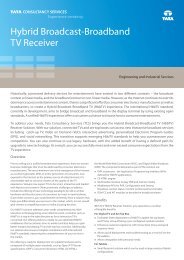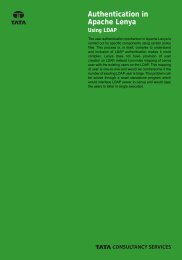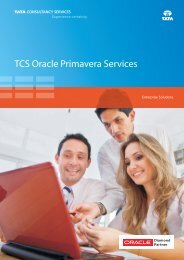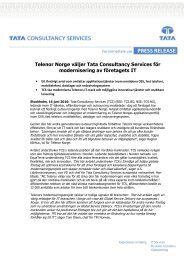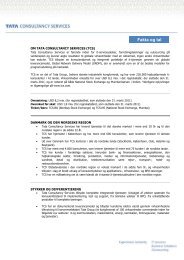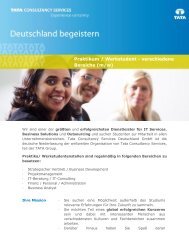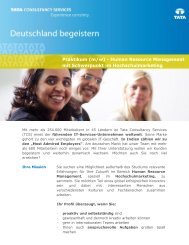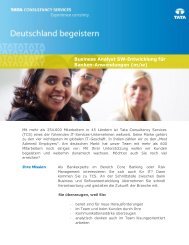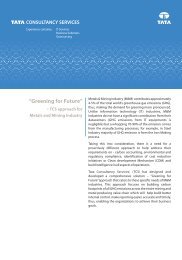Pharma S&M Analytics - Tata Consultancy Services
Pharma S&M Analytics - Tata Consultancy Services
Pharma S&M Analytics - Tata Consultancy Services
Create successful ePaper yourself
Turn your PDF publications into a flip-book with our unique Google optimized e-Paper software.
Changing Scenario in Sales and<br />
Marketing of <strong>Pharma</strong>ceutical<br />
Industry: Role of IT<br />
Emergence of IT has made a significant impact in every<br />
possible industry. IT revolution made conventional<br />
things look unconventional and abstract things look<br />
very conventional, still practically increasing and<br />
expanding horizons of business beyond limits and<br />
boundaries. <strong>Pharma</strong>ceutical industry is perhaps one of<br />
the highly regulated industries that is ever changing<br />
and ever evolving due to changing R & D scenario,<br />
increasing regulatory constraints, growing competition<br />
and diminishing returns. Industry is also changing its<br />
traditional methods of doing business and is opting for<br />
flexible IT business models, like Customer Relationship<br />
Management (CRM) and business analytics, in Sales and<br />
Marketing to:<br />
• Understand customer-market dynamics<br />
• Design meaningful market strategies<br />
• Improve sales force effectiveness<br />
• Increase returns<br />
This paper, “Changing Scenario in Sales and Marketing<br />
of <strong>Pharma</strong>ceutical Industry: Role of IT”, discusses<br />
challenges of pharmaceutical Sales & Marketing, details<br />
possible strategies and role of IT in Sales & Marketing<br />
with emphasis on CRM, business analytics and e-<br />
marketing.
Changing Scenario in Sales and Marketing of <strong>Pharma</strong>ceutical Industry: Role of IT<br />
About the Author<br />
Ravindranath Babu<br />
Ravindranath Babu has been working in the IT industry for<br />
the last 2 years. He is a Functional Consultant for <strong>Pharma</strong><br />
Sales & Marketing. He is engaged in the development of<br />
<strong>Pharma</strong> Sales & Marketing solution in Siebel <strong>Pharma</strong><br />
analytics platform. He has experience in therapy areas like<br />
cardiovascular, critical care, gynecology, diabetes, oncology<br />
and women’s health care. Earlier, he worked for Astrazeneca<br />
<strong>Pharma</strong> Ind. Ltd as a Medical Information Associate, where<br />
he handled medical information aspects of Sales &<br />
Marketing. He was also a faculty for Medical & Product<br />
Training sessions and had prepared publication alerts,<br />
designed promotional inputs with brand management<br />
team and had rolled out medico-marketing strategies to<br />
field force.<br />
Acknowledgements<br />
I thank Dr Babu S Nema, Head - <strong>Pharma</strong> Innovation for<br />
providing guidance and support in writing this white paper.<br />
1
Changing Scenario in Sales and Marketing of <strong>Pharma</strong>ceutical Industry: Role of IT<br />
Table of Contents<br />
1. Introduction 3<br />
Changing R&D Scenario 3<br />
Patent Expiries and Generics 5<br />
Prevailing Regulatory Environment 6<br />
Changing Customer - Market Dynamics 8<br />
IT in <strong>Pharma</strong>ceutical Sales & Marketing 10<br />
2. Conclusion 17<br />
3. References 17<br />
2
Introduction<br />
<strong>Pharma</strong>ceutical industry is one of the highly regulated industries. Various advancements like scientific,<br />
technological, medical, diagnostic and so on pose a great challenge to pharmaceutical industry as the investment in<br />
R&D is high. Thus the industry heavily relies on Sales and Marketing—the revenue generator in entire<br />
pharmaceutical value chain—to maximize the returns. Sales & Marketing is also undergoing a great transformation<br />
especially in developed markets due to:<br />
• Changing R&D scenario<br />
• Patent expiries and generics<br />
• Prevailing regulatory environment<br />
• Changing customer-market dynamics<br />
This white paper attempts to detail the cause of the transformation in developed markets; strategies that will help to<br />
cope with these transformation; and factors that will improve the revenue of the industry.<br />
Changing R&D Scenario<br />
As per Tufts Center for the study of drug development estimate, the cost to get an innovative new drug to market is<br />
more than USD 800 million including expenditures on failed projects and the value of forgone alternative<br />
investments. Currently, total R&D spent by top ten companies is more than USD40 bio/year.<br />
Companies spending in excess of USD1bn on R&D per annum are expecting to market a mean of 1.8 NMEs per year<br />
until 2005, a growth of 60% over the 1.1 seen between 1994 and 1998.<br />
Over a period, NMEs applications as well as approvals have shown a steady decline.<br />
“Pfizer, at $8-9 billion, spends<br />
more on R&D than the total of<br />
India’s defence budget,”<br />
- Mr Kapil Sibal,<br />
Union Minister of Science and<br />
Technology and Earth Sciences<br />
Source - Research and Development in the <strong>Pharma</strong>ceutical Industry: Oct 2006: a CBO study<br />
Source – Impact of Genomics on<br />
antimicrobial Drug Discovery;<br />
Guangyi Wang, Ph: Spring 2007<br />
b 100<br />
Success rate (%)<br />
90<br />
80<br />
70<br />
60<br />
50<br />
40<br />
30<br />
20<br />
10<br />
0<br />
Changing Scenario in Sales and Marketing of <strong>Pharma</strong>ceutical Industry: Role of IT<br />
“The total number of NMEs approved each year fell from a high of 53 in 1996<br />
to 17 in 2002.Annual approvals rebounded to 36 by 2004 but fell again in<br />
2005, to 20.The number of applications for approval of new molecular<br />
entities has exhibited a similar pattern. Applications rose sharply in<br />
1995—the year before the peak in approvals—generally declined from<br />
1998 to 2002, and rose again in 2003 and 2004.The drop in approvals since<br />
1996 could simply mark a return to their long-term average, but even so, the<br />
pace of new-drug approvals has not matched the rise in real R&D spending,<br />
as a result, the average R&D cost per new drug has grown significantly.”<br />
I II III Reg.<br />
Stage of development<br />
Figure 1: Stage of Development<br />
3<br />
App.
The success rate of NMEs, inclusive of all therapy areas, especially in phase III (see Figure 1), registration and final<br />
approval, is less than 10-20%. Though the expenditure on R&D in US pharmaceutical industry has increased, the<br />
number of patents per dollar has considerably reduced. Due to weak late stage pipeline, the Sales & Marketing<br />
teams are compelled to improve revenues from existing product port folios.<br />
Possible Strategies<br />
Some possible strategies from Sales & Marketing perspective that are relevant to current R & D scenario and that can<br />
aid companies in realizing & improving the revenues from the existing product port folios are listed in this section.<br />
1. Proper Product Life Cycle (PLC) management or brand management based on:<br />
• Creating proper market segmentation, targeting and positioning<br />
• Producing right kind of products for right customers with right promotional mix<br />
• Tracking market changes and trends<br />
• Monitoring disease/therapy area and competitor trends<br />
• Building robust customer-campaign management<br />
2. New indications based on:<br />
• Guidelines<br />
• Clinical trials/studies<br />
Recommendations made by medical and regulatory bodies<br />
• Market and therapy area trends<br />
3. Indication penetration and expansion based on:<br />
• Physician experience, patient compliance and usage levels of the drug in an approved indication.<br />
• Extent of usage.<br />
• Span of usage.<br />
• New areas of usage.<br />
4. Subgroup focus based on:<br />
• Drug preferences and usage in various subgroups (based age or disease).<br />
• Adoption or usage levels of a drug by different physician groups in different subgroups.<br />
• Gaps in the management or treatment options.<br />
5. Focus on combination therapies and co prescriptions based on:<br />
• Most widely used combinations.<br />
• Most preferred combinations.<br />
• Commonly used co prescription drugs and impact on outcomes.<br />
• Combination and co prescription patterns in various specialties.<br />
6. DTC marketing with a focus on:<br />
• Retailer business and purchase trends<br />
• Promotional strategy and impact<br />
• Channel and campaign management<br />
Changing Scenario in Sales and Marketing of <strong>Pharma</strong>ceutical Industry: Role of IT<br />
4
Patent Expiries and Generics<br />
Not only reduced number of NME applications, decreased number of drug approvals and decreased periods of<br />
exclusivity (see Figure 2) has led to drying up of late stage pipeline, but also led more number of patented drugs (that<br />
include blockbuster drugs) in the verge of patent expiries. Thus, companies have become more vulnerable to market<br />
threats. As per Datamonitor analysis:<br />
Figure 2: Declining Periods of Exclusivity for Novel Classes of Products<br />
The generics market globally has grown by 20% in 2005, four times that of patented drugs and over three times that<br />
of pharmaceutical market. It is estimated to grow at a Compound Annual Growth Rate (CAGR) of 13.62% during the<br />
five-year period 2006-10 with revenues reaching $83.9bn. The market expansion and growth has been triggered by<br />
the rising number of patent expiries of blockbuster drugs and increasing healthcare expenditure. With over 39 major<br />
drugs, due to lose their patent protection before 2010 and branded drug growth rates beginning to falter with<br />
growth rates of only 5-7%, generic companies are prepared to gain even further market share. The US has the largest<br />
generics market and account to 44% of the global generics market. Teva <strong>Pharma</strong>ceuticals, based in Israel is the<br />
market leader in this industry followed by Sandoz.<br />
Currently, one of the prime challenges of Sales & Marketing teams is to sustain revenues by alternative means and<br />
approaches for their block buster drugs that are going off patent.<br />
Possible Strategies<br />
Many originator companies are trying to sustain revenues of their block buster drugs either by entering into<br />
agreements/pacts with generic companies or by launching their own generic versions. The Sales & Marketing efforts<br />
can be planned based on:<br />
• Ratio analysis<br />
• Historical trend analysis<br />
• Linear regression analysis<br />
• Forecasting and Cause-effect analysis<br />
Some possible strategies to improve the revenues of block buster drugs in terms of Sales & Marketing that have more<br />
relevance and significance with patent expiries and generics are listed in this section.<br />
1. Line extensions based on:<br />
• Market size and market share.<br />
• Competitive differentiation.<br />
• Promotional support, pricing and launch timing.<br />
• Value add and customer acceptance.<br />
Changing Scenario in Sales and Marketing of <strong>Pharma</strong>ceutical Industry: Role of IT<br />
5<br />
…on average across the six<br />
markets, branded manufacturers<br />
faced a 35% erosion of their<br />
franchise revenues and 45%<br />
erosion of volume after two years<br />
of generic competition, with brand<br />
volume erosion most severe in UK<br />
and US at 57%, and the least severe<br />
in Spain and Italy at only 22%.
2. Focus on emerging markets or BRIC markets to improve returns is based on:<br />
• Geographical, demographical, behavioral and psychographic details of the markets.<br />
• Understanding customer-market needs.<br />
• Estimation of market potential.<br />
• Evaluation of different therapy areas.<br />
• Proper Market strategy<br />
3. Aggressive product launches to gain maximum share of voice (including BRIC or emerging markets) and it<br />
requires:<br />
• Thorough market understanding.<br />
• Robust market strategy.<br />
• Market and customer specific approach.<br />
4. More focus on planned pre-launch and early launch activities to get:<br />
• Better customer-market insight.<br />
• Competitor understanding.<br />
• Evaluation reports on all major stake holders in the value chain.<br />
• Mileage over competition.<br />
5. Switch patients to next generation drugs to balance existing brand defense strategies based on:<br />
• Current usage patterns of various drugs.<br />
• Disease/Therapy area trends.<br />
• New practices or approaches in disease management.<br />
6. Licensing and market cross over strategies based on:<br />
• Strength of the individual companies.<br />
• Demographic details, market trends and regulations.<br />
• Market potential and forecasting.<br />
• Market strategy.<br />
Prevailing Regulatory Environment<br />
Prevailing regulatory environment is a result of behavioral aspects of the industry in the market as well as growing<br />
health concern, increasing awareness, rising public interest, issues and negative events within the pharmaceutical<br />
industry due to fierce competition, increasing R&D costs and diminishing returns.<br />
As per Michael Rasmussen and Laura Ramos:<br />
Changing Scenario in Sales and Marketing of <strong>Pharma</strong>ceutical Industry: Role of IT<br />
<strong>Pharma</strong>ceutical companies paid more than $3 billion in regulatory settlements<br />
and criminal fines since 2000 as the US Department of Health & Human <strong>Services</strong><br />
(HHS) Office of the Inspector General (OIG) and state attorneys general put their<br />
sales, pricing, and promotional activities under closer scrutiny.<br />
6
Regulatory Bodies and their Principles<br />
1. European Medicines Agency (EMEA)<br />
EMEA mission statement is:<br />
2. Medicines and Healthcare Products Regulatory Agency (MHRA)<br />
MHRA’s primary objective is:<br />
3. European Federation of <strong>Pharma</strong>ceutical Industries and Associations (EFPIA)<br />
EFPIA is conscious of the importance of providing accurate, fair and objective information about medicinal<br />
products so that rational decisions can be made as to their use.<br />
4. Division of Drug Marketing, Advertising and Communications (DDMAC)<br />
DDMAC mission is<br />
5. <strong>Pharma</strong>ceutical Research and Manufactures of America (PhRMA)<br />
PhRMA follows the highest ethical standards as well as legal requirements. This code reinforces that interactions<br />
with healthcare professionals are to benefit patients and to enhance the practice of medicine.<br />
6. International Federation of <strong>Pharma</strong>ceutical Manufacturers and Associations (IFPMA)<br />
IFPMA and its members provide educational and promotional efforts that benefit patients and promotional<br />
programs and collaborations that enhance the practice of medicine. IFPMA also preserves the independence of<br />
the decisions taken by healthcare professionals in prescribing medicines to patients.<br />
Promotional compliance includes:<br />
• Advertisements and mailings<br />
• Detail Aids, brochures and others<br />
• Internet sites<br />
• Exhibition panels, videos and others<br />
• Gifts, samples and others<br />
• Reprints and others<br />
• Hospitality<br />
• Representative’s Activities.<br />
• Meetings/Symposia<br />
• Public Relations<br />
• Any other communication<br />
Changing Scenario in Sales and Marketing of <strong>Pharma</strong>ceutical Industry: Role of IT<br />
To contribute to the protection and promotion of public health<br />
is to safeguard public health by ensuring that all medicines on the UK market meet appropriate<br />
standards of safety, quality and efficacy.<br />
To protect the public health by assuring prescription drug information is truthful, balanced, and<br />
accurately communicated.<br />
Promotional activities exclude:<br />
• Medical Information<br />
o Responses to specific enquiries<br />
• Shareholder/business communications<br />
o Prescribed Information<br />
• Patient Information Leaflets<br />
o Price Lists<br />
Source – ‘Sales and marketing standards in US and EU: Speaking the same language?’-Paul woods, AstraZeneca<br />
7
Possible Strategies<br />
Some possible strategies to comply with current prevailing regulatory environment from an Sales & Marketing<br />
perspective are listed in this section. An unbiased approach in terms of communication, education to physicians to<br />
improve prescribing habits and in turn patient outcomes are based on:<br />
• Appropriate and right communication to right customers.<br />
• Evaluating type, ways and means of communication.<br />
• Validation of communication.<br />
Promotional activities with focus on providing optimal cost effective treatments are based on:<br />
• Physician-patient interests<br />
• Meaningful and effective communication that can balance the business and customer benefits.<br />
• Third-party financial arrangements should incentivize compliance all along the supply chain.<br />
Focus on pharmacovigilaince and drug safety activities that have tremendous impact on entire product life cycle<br />
(PLC) are based on:<br />
• Tracking adverse effects and untoward side effects for the marketed product in a proper form or method.<br />
• Post market surveillance studies<br />
Changing Customer - Market Dynamics<br />
<strong>Pharma</strong>ceutical industry is witnessing one of the greatest transformations in terms of customer–market dynamics.<br />
Not only the key changes like emergence of specialty and super specialty segments, increased regulatory<br />
constraints, focus on sub groups in various therapy areas and information explosion in recent times have made the<br />
situation complex, but also complicated for the pharmaceutical companies to have a right and meaningful market<br />
strategy that can address customers in an appropriate way.<br />
Past Scenario in Customer-Market Dynamics<br />
• Majority of doctors were general practitioners and physicians<br />
• Specialty medicine and super specialty were at the verge of emergence<br />
• Needs, wants and expectations were not given importance in company’s expectations<br />
• Products had clear cut benefits over predecessors<br />
• Scientific data was simple, understandable and easily interpretable<br />
• Manageable R&D costs and less burden on Sales & Marketing teams<br />
• Congenial and flexible regulatory environment with very less specifications and norms<br />
• Less legal and insurance hassles<br />
Current and Emerging Scenario in Customer-Market Dynamics<br />
• Emergence of sub-groups as important areas of focus<br />
• Specialty and super specialty segments<br />
• Emergence of physicians as ‘valued partners’<br />
• Patient as a focal point<br />
• Direct to consumer marketing<br />
• Healthcare network<br />
• Personalized medicine<br />
• Rising R&D costs<br />
• Increased medical and regulatory constraints<br />
• More legal and insurance hassles<br />
Changing Scenario in Sales and Marketing of <strong>Pharma</strong>ceutical Industry: Role of IT<br />
8
Changing Scenario in Sales and Marketing of <strong>Pharma</strong>ceutical Industry: Role of IT<br />
• New business models that focus on emerging markets, mass blockbusters and so on<br />
• Proactive involvement of Sales & Marketing departments in drug development<br />
These factors led the pharmaceutical companies to cut costs with an objective to become lean and agile<br />
organizations. And Sales & Marketing teams had to focus on diminishing for the following reasons:<br />
• Declining cost-effectiveness of existing sales force combined with diminishing returns from incremental sales<br />
team (see Figure 3)<br />
• End market fragmentation<br />
Figure 3: Declining Cost Effectiveness of Sales Force<br />
Possible Strategies<br />
All though some of the previously mentioned strategies have some relevance to ‘changing customer – market<br />
dynamics’, following are some specific and possible strategies.<br />
1. Multi-channel approach to customer (call centre, internet and others) based on:<br />
• Using the right channel to the right customer based on the market data and customer information.<br />
• Evaluation of the channel based on the target customer group.<br />
• Tailor-made design and customized messages to answer individual needs of specific customer group.<br />
• Understanding of physician preferences and prescribing habits that can be helpful to Sales & Marketing<br />
teams in streamlining communication strategy to physicians.<br />
• Follow up and feedback.<br />
2. Value added services to improve patient compliance to therapy/treatment based on:<br />
• Patient education/awareness programmes.<br />
• Relationship management centers.<br />
• Ease of availability of medicines or drugs.<br />
3. Marketing–Co-promotions using Strength, Weaknesses, Opportunities and Threats (SWOT) analysis based on:<br />
• Understanding of market size.<br />
• Understanding customer preferences.<br />
• Equity and customer base.<br />
• Market plan and customer approach.<br />
9
4. New distribution models based on:<br />
• Flexibility.<br />
• Adoptability.<br />
• Consistency and reproducibility.<br />
5. Mass block buster business models based on:<br />
• Epidemiology and demographic details of the markets.<br />
• Market potential and forecast.<br />
• Therapy area and disease trends.<br />
• Market strategy and approach.<br />
IT in <strong>Pharma</strong>ceutical Sales & Marketing<br />
Changing Scenario in Sales and Marketing of <strong>Pharma</strong>ceutical Industry: Role of IT<br />
Traditionally Sales & Marketing from pharmaceutical industry considered<br />
physician as prime target (see Figure 44) and sales representative as only<br />
medium of communication with very less or no focus on patients and retail<br />
outlets.<br />
Traditional model of pharma Sales & Marketing<br />
Company<br />
Sales Rep<br />
Doctor<br />
Static detailing aids<br />
Paper reporting<br />
Influences<br />
Prescription Generation<br />
Patient<br />
Figure 4: Traditional Model of <strong>Pharma</strong> Sales & Marketing<br />
Due to competition, pharmaceutical industry focus shifted from product centric through market centric to<br />
customer centric with renewed focus on physicians, patients and other major stake holders in the value chain (see<br />
Figure 5). Hence, managing and maintaining customer relationship became a strategic imperative for<br />
pharmaceutical Sales & Marketing. Thus, Customer Relationship Management (CRM) has become one of the most<br />
significant areas of focus for Sales & Marketing organizations in pharmaceutical industry.<br />
10<br />
Rx<br />
Drugs<br />
Depot or CFA<br />
Wholesaler or<br />
Superstockist<br />
Retailer (Hospital<br />
<strong>Pharma</strong>cist or<br />
<strong>Pharma</strong>cist)
Web portal<br />
New model of pharma Sales & Marketing<br />
Company<br />
CRM(SFA) BI, e-detailing<br />
Sales Rep<br />
Doctor<br />
Influences<br />
Figure 5: New Model of <strong>Pharma</strong> Sales & Marketing<br />
CRM<br />
Objective of CRM<br />
• To sustain and enhance the intensity of customer interaction at one or more customer touch points with proper<br />
channel management<br />
• To allow and establish a multilevel and uniform view on customer data<br />
It helps:<br />
• To address prospective and attractive customers through proper channel<br />
• To decrease the customer service costs and improve returns, and<br />
• To improve customer retention by providing customized and tailor made offerings to existing and new<br />
customers<br />
Many big pharma companies have made significant investments in the area of CRM and it is currently focused on<br />
sales force automation and call center support.<br />
H1 2007 Tech trends indicates that CRM solutions are the second most deployed applications in terms of frequency<br />
The CRM market for services will grow to nearly $2.8 billion by 2012. This is a Compound Annual Growth Rate (CAGR)<br />
of 12.1% from 2007 to 2012. Certain segments of the market, such as the enterprises with fewer than 100 employees<br />
and those with 100 to 1,000 employees, are set to grow even faster, reaching a CAGR of 14% to 16 %<br />
16%<br />
Sales Force Automation<br />
14%<br />
12% 18%<br />
40%<br />
Customer Service Automation Customer <strong>Analytics</strong><br />
On-Demand CRM<br />
Patient<br />
Prescription Generation<br />
Changing Scenario in Sales and Marketing of <strong>Pharma</strong>ceutical Industry: Role of IT<br />
Advertising,DTC<br />
Online mktg<br />
Direct supply, DTC<br />
Awareness/edu campaigns<br />
11<br />
Rx<br />
Drugs<br />
Marketing Automation<br />
Depot or CFA<br />
Wholesaler or<br />
Superstockist<br />
Retailer (Hospital<br />
<strong>Pharma</strong>cist or<br />
<strong>Pharma</strong>cist)<br />
“Kalustian et al. observed that CRM “has become a pharma buzzword, but few<br />
companies actually practice it. ”<br />
Figure 6: <strong>Pharma</strong> Sales & Marketing <strong>Analytics</strong> Architecture
Changing Scenario in Sales and Marketing of <strong>Pharma</strong>ceutical Industry: Role of IT<br />
Business <strong>Analytics</strong><br />
Analytical CRM brings together data from operational CRM applications and other data sources and uses and<br />
analyzes this information so that companies can maximize the value of the data or information available in various<br />
repositories. The effective analysis of data may enable pharmaceutical companies to get an insight into available<br />
customer- market data and in developing a meaningful, customer centric Sales & Marketing strategy.<br />
Business analytics allows seamless integration of data from various disparate sources, that is, transactional,<br />
operational and analytic sources, and provides actionable insight into Sales & Marketing activities. They can be rolebased<br />
business intelligence applications that combine comprehensive physician profiles, promotional activities,<br />
campaigns, and medical education events with prescription and market share data.<br />
“In the Post Enron Economy the need for transparency has also impacted the way<br />
global pharmaceutical CXO's think about their particular business processes, and<br />
continued heightened regulatory environment. Business Intelligence systems for<br />
pharmas have become what ERP was for manufacturers in the late 1980's. HIPAA,<br />
drug discovery pipeline, and overall business score carding dashboards, are<br />
mandatory in the competitive global pharma landscape.”<br />
The integration of business analytics with CRM data sources or company’s internal data sources, prescription<br />
monitoring and marketing management/product management tools or various market research tools can<br />
• Give insight into market, market potential, forecasting, market trends (current and future), segmentation,<br />
therapy area trends (current and future), competitor presence, company’s strengths, market strategy and so on.<br />
• Help to understand market and therapy area trends, current and future prescription trends that can be helpful to<br />
devise an appropriate market strategy for line or brand extensions.<br />
• Give customized view of the market with a thorough understanding of sales, trends and market share by<br />
product or therapy area in respective markets.<br />
• Provide deep and meaningful insight into successful launches, which can in turn help Sales & Marketing teams in<br />
devising ideal product launch strategy.<br />
• Give insights into availability, prescriptions, sales, competitor information (pricing, promotional spent),<br />
physicians’ prescribing and diagnostic patterns that can help in building up an appropriate marketing strategy,<br />
before the launch of a product.<br />
• Provide insights into current and emerging prescribing patterns along with therapy area trends that can be<br />
useful in understanding level of acceptance and adoption to new or next generation drugs. This can in turn be<br />
helpful in developing a market or sales strategy.<br />
12<br />
Malcolm Frank<br />
CEO, President<br />
CXO Systems<br />
October, 2003<br />
Source - Business Intelligence Solutions for the <strong>Pharma</strong>ceutical Industry: The Gantry Group LLC: 2004
Source Data<br />
CRM<br />
IMS<br />
NDC<br />
Other Sources<br />
Changing Scenario in Sales and Marketing of <strong>Pharma</strong>ceutical Industry: Role of IT<br />
<strong>Pharma</strong> Sales & Marketing <strong>Analytics</strong> Architecture<br />
ETL Database Layer Presentation Layer<br />
Identify details<br />
Transformation<br />
Incremental<br />
Load<br />
OLAP<br />
Database<br />
e-Marketing<br />
e-Marketing is designing, developing and implementing marketing strategies or programmes through internet and<br />
other technologies of communication to satisfy customer needs thereby achieving specific marketing goals.<br />
Conceptually, e-marketing is same as marketing or part of marketing, but methods and approaches are different. All<br />
e-marketing programmes should attract and involve customers; retain the customers by building relationships and<br />
motivate them to action.<br />
“e” is another way of marketing or selling a product. It is primarily used to increase the reach and expand the<br />
customer base.<br />
It is used to improve communication (speed, specificity, access and so on) that is heart of any marketing strategy and<br />
to reduce cost and improve returns.<br />
e-Marketing includes – e-detailing, Web sites, Personal Digital Assistant (PDAs), Point of care devices(PCD), Web casts<br />
and e-congresses, Mobile phone access, e-mail, online calculators and other tools.<br />
e-Marketing or the integration of business analytics with SFA, CRM applications, market management tools, market<br />
research tools or company’s internal data sources and S&D applications provided by IT in pharmaceutical industry<br />
helps:<br />
• Develop a communication strategy for a specific channel and get an insight into communication impact.<br />
• Develop a comprehensive strategy by giving insights into managed care markets.<br />
• Provide customer–market understanding, customer base and reach of the company, strength of the company<br />
based on therapy area, product, prescriber and patient type that can be useful in developing go-to market plan.<br />
• Customize Sales and Distribution (ERP) applications based on the dynamic requirements of the company or the<br />
market or the customer.<br />
• Get thorough market understanding, disease and therapy area trends of respective markets. Also useful in<br />
estimating market potential, forecasting, developing market strategy and so on.<br />
e-Marketing is useful to expand customer base, speed up communications, and offer better customer services<br />
leveraging internet.<br />
13<br />
Business <strong>Analytics</strong><br />
Sales Force Alignment<br />
Customer Segmentation<br />
Forecasting<br />
Sales <strong>Analytics</strong><br />
ROI <strong>Analytics</strong><br />
Meded <strong>Analytics</strong><br />
Executive <strong>Analytics</strong><br />
Marketing <strong>Analytics</strong><br />
Business <strong>Analytics</strong>: comprises an entire set of prebuilt pharma sales, services, and marketing analytics<br />
components and toolset that enables a uniform, complete and multidimensional view of pharmaceutical<br />
customer relationship, affiliations, call activities, medical information requests, product issues, matket<br />
share & sales, prescriptions, sales quotas, territory planning, forecasting, ROI analysis and segmentation.<br />
Figure 7: <strong>Pharma</strong> Sales & Marketing <strong>Analytics</strong> Architecture
Changing Scenario in Sales and Marketing of <strong>Pharma</strong>ceutical Industry: Role of IT<br />
e-detailing<br />
Money spent on promotional activities is one of the largest expenditure in pharma industry. About 45 % of that<br />
money is spent on sales representatives. So cost of detailing a doctor face-to-face is highly expensive and it is $150 -<br />
$200 per visit and at least $3,000 per hour of face time with a physician.<br />
Research shows that only 7% of the sales representatives in the U.S. are able to interact with the physician for<br />
duration of more than 2 minutes. Three prime reasons are:<br />
• Decreased effectiveness<br />
• Physicians with tight schedules and little time to med representatives<br />
• Access to internet<br />
These reasons were drivers for the concept of e-detailing. Research shows customer stay to a tune of 8 minutes for an<br />
online or e-detail. This clearly exhibits potential of e-detailing over conventional methods of static detailing.<br />
A six-month 1,130-doctor study with i-PhysicianNet showed a 25% reduction in<br />
detailing cost. In addition, the average length of each detail doubled as did the<br />
number of details per rep per day.<br />
Figure 8: Survey Results of E-detailing<br />
e-detailing and a strong CRM understanding can be complimentary to the sales force to understand a customer and<br />
customizing the key messages based on customer information, need, requirement and situation and gives an<br />
opportunity to improve quality as well as quantity or time of interaction.<br />
Sales & Marketing solution or <strong>Pharma</strong> Sales and Managed care solutions (integrated with pharmacovigilance or drug<br />
safety reporting systems) can be customised depending on the promotional policy (IFPMA, PhRMa and so on) of the<br />
company. The functional requirements with specific controls based on key areas will ensure compliance. The Sales &<br />
Marketing solution provided by IT in pharmaceutical industry helps to:<br />
• Decide, evaluate and validate communication strategy with a focus on customer type and compliance.<br />
• Facilitate Sales & Marketing teams to develop effective market strategy that can balance business returns and<br />
physician–patient interests and also has compliance as an integral part of it.<br />
• Get useful and good insight about adverse events or side effect profile of the drug in a much larger population<br />
after market availability and wide usage for the medico-marketing teams.<br />
14
Conclusion<br />
Changing Scenario in Sales and Marketing of <strong>Pharma</strong>ceutical Industry: Role of IT<br />
Currently in pharmaceutical industry, where innovation in true sense is taking a new shape in the form of new<br />
business models, outsourcing, collaborations, still leadership in Sales & Marketing is the crux for any commercial<br />
strategy. Companies can see success, when they aggressively involve all major stake holders in a tactful<br />
engagement.<br />
References<br />
One-to-one marketing solutions like personalized communications have a<br />
powerful impact on customers. They increase response rates by 34%, order size by<br />
25% and repeat business by 48%. - Industry analyst Info Trends<br />
… direct web-driven marketing sales this year is nearly $1.9 billion and by 2012 this<br />
will double, reaching nearly $3.8 billion. - DMA report, 2008<br />
Though there are certain limitations like geographical, developmental, educational, market and operational,<br />
success in Sales & Marketing is only possible by adopting a robust IT strategy. This involves optimal utilization of CRM,<br />
BI and other web-based services based on mode of operation, extent of operation and level of operation in a given<br />
location with a right application framework in place, which can lead to optimal channel management, better insight<br />
into Sales & Marketing outcomes and ultimately increased sales.<br />
A CBO study - Research and Development in the <strong>Pharma</strong>ceutical Industry: Oct 2006<br />
Business Intelligence Solutions for the <strong>Pharma</strong>ceutical Industry: The Gantry Group LLC: 2004<br />
Closed Loop Marketing solutions for sales and marketing effectiveness Updated: March 30, 2005<br />
(www.microsoft.com)<br />
Credit Suisse/Scott Levin, 2001<br />
Global <strong>Pharma</strong>ceutical Industry Facts and Figures As at July 2007: MEDICINES Australia<br />
Impact of Genomics on antimicrobial Drug Discovery; Guangyi Wang, Ph: Spring 2007<br />
PhRMA, 2001<br />
Reference materials from TCS Internal data<br />
‘Sales and marketing standards in US and EU: Speaking the same language?’-Paul woods, AstraZeneca<br />
Transformation in the <strong>Pharma</strong>ceutical Industry – Developing Customer Orientation at <strong>Pharma</strong> Corp: 16th Bled<br />
eCommerce Conference eTransformation Bled, Slovenia, June 9 - 11, 2003<br />
Value Driver Report Business Intelligence Solutions for the <strong>Pharma</strong>ceutical Industry: The Gantry Group LLC:2004<br />
www.I-PhysicianNet.com<br />
15
About Life Sciences and Healthcare<br />
Practice<br />
With an experienced team of over 3,500 professionals – including<br />
biomedical engineers, computational chemists, biologists,<br />
pharmacologists, physicians, validation specialists, IT architects and<br />
management consultants - TCS LSHC unit helps customers achieve<br />
their business objectives in the following areas.<br />
• Rising R&D costs<br />
• Pipeline failures<br />
• Safety-based drug withdrawals<br />
• Patent expiry<br />
• Ensuring patient safety<br />
• Compliance with quality standards<br />
• Medical accuracy in Healthcare<br />
TCS Provides comprehensive strategy for creating efficiency at<br />
every stage of customer’s operations, which may include but are not<br />
limited to the following:<br />
• Accelerated drug development<br />
• Reduced clinical trial costs<br />
• Integrated care delivery networks<br />
• Re-evaluation of safety standards<br />
• More accurate diagnostics<br />
• Targeted medicines<br />
• Faster, more time and cost-effective clinical care<br />
Subscribe to TCS White Papers<br />
TCS.com RSS: http://www.tcs.com/rss_feeds/Pages/feed.aspx?f=w<br />
Feedburner: http://feeds2.feedburner.com/tcswhitepapers<br />
www.tcs.com<br />
About <strong>Tata</strong> <strong>Consultancy</strong> <strong>Services</strong> (TCS)<br />
<strong>Tata</strong> <strong>Consultancy</strong> <strong>Services</strong> Limited is an IT services, business solutions<br />
and outsourcing organization that delivers real results to global<br />
businesses, ensuring a level of certainty no other firm can match. TCS<br />
offers a consulting-led, integrated portfolio of IT and IT-enabled<br />
services delivered through its unique Global Network Delivery<br />
TM<br />
Model , recognized as the benchmark of excellence in software<br />
development.<br />
A part of the <strong>Tata</strong> Group, India's largest industrial conglomerate, TCS<br />
has over 100,000 of the world's best trained IT consultants in 50<br />
countries. The company generated consolidated revenues of US $5.7<br />
billion for fiscal year ended 31 March 2008 and is listed on the<br />
National Stock Exchange and Bombay Stock Exchange in India. For<br />
more information, visit us at www.tcs.com<br />
lshcip.pmo@tcs.com<br />
All content / information present here is the exclusive property of <strong>Tata</strong> <strong>Consultancy</strong> <strong>Services</strong> Limited<br />
(TCS). The content / information contained here is correct at the time of publishing.<br />
No material from here may be copied, modified, reproduced, republished, uploaded, transmitted,<br />
posted or distributed in any form without prior written permission from TCS. Unauthorized use of the<br />
content / information appearing here may violate copyright, trademark and other applicable laws, and<br />
could result in criminal or civil penalties.<br />
Copyright © 2009 <strong>Tata</strong> <strong>Consultancy</strong> <strong>Services</strong> Limited



